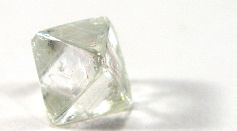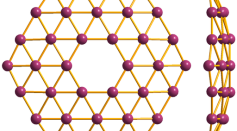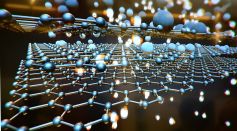Tags: Graphene

Synthetic Diamonds Produced in Liquid Metal at Ambient Temperatures, Pressure Form in Just 15 Minutes
Electron Vortices Detected Directly in Graphene for the First Time Using High-Resolution Magnetic Field Sensor

Chiral 2D Borophene Nanoplatelets Could Make Advanced Sensors and Implantable Medical Devices Better Than Graphene
Meet Goldene: The Free-Standing Sheet of Gold Only One Atom Thick
Organic Superconductors With Ultrafast Electrons Show Exceptional Properties Comparable to Graphene
Electrons Become Fractions of Themselves in Graphene for the First Time, Enabling More Robust Form of Quantum Computing

Graphene Plasmonic Sensor Uses Surface Acoustic Wave for Fingerprinting Proteins and Peptides
Graphene Quantum Dots Developed As Metal-Free Nanozymes Show Potential for Chemodynamic Cancer Therapy

Breakthrough in Graphene: Novel Semiconductor Signals Leap Towards Faster PCs, Quantum Computers
Artificial Intelligence Used in High-Performance Graphene Sensor Detects Bacteria and Toxins in Drinking Water

Humans As Batteries: Future Smart Devices Could Use Our Bodies As Power Source

Graphene: The Supermaterial Shaping the Future of Science and Engineering

Scientists and Engineers Develop New Approach to Come Up With 'Smart' Materials

Graphene-Based Electronics: Can This Replace Silicon Microelectronics, Semiconductors?
Naturally Occurring Double-Layer Graphene Used in New Research to Observe Quantum Mechanical Impacts

Nanoporous Sponge Anchored on Graphene Produces Faster, More Efficient Wastewater Treatment

Advanced Graphene Pressure Sensors Set to Revolutionize Prosthetic, Robotic Limbs

Nano-Petri Dish Created by Scientists Allows the Observation of Atom Behavior in Liquid
Imaging Technique Accelerated to Capture Structures of Tiny Molecules, Enhancement of Daily Life Applications from Plastics to Pharmaceuticals

Scientists Successfully Create the Next-Generation Wonder Material Called 'Graphyne' for Better Electronics, Optics
Most Popular

Largest Known Volcanic Aquifer Discovered Beneath Oregon's Cascades

New 'Supergiant' Sea Bug Found in South China Sea, Named After Darth Vader

Mediterranean Sea Was Refilled by a Catastrophic Flood Millions of Years Ago

Mysterious Cosmic Waves That Sound Like Birds Detected in Unexpected Space Region




